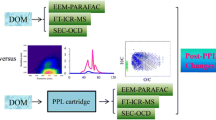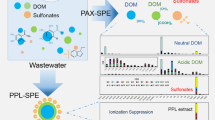Abstract
We compare two methods, solid-phase extraction (SPE) and dialysis, commonly used for extraction and concentration of dissolved organic matter (DOM) prior to molecular characterization by electrospray ionization (ESI) and ultrahigh-resolution Fourier transform ion cyclotron resonance mass spectrometry. Spectra of DOM samples from Minnesota and Sweden peatlands that were extracted with styrene divinyl benzene polymer SPE sorbents included ions with formulas that had higher oxygen to carbon (O/C) ratios than spectra of DOM from the same samples after de-salting by dialysis. The SPE method was not very effective in extracting several major classes of DOM compounds that had high ESI efficiencies, including carboxylic acids and organo-sulfur compounds, and that out-competed other less-functionalized compounds (e.g., carbohydrates) for charge in the ESI source. The large abundance of carboxylic acids in the dialysisextracted DOM, likely the result of in situ microbial production, makes it difficult to see other (mainly hydrophilic) compounds with high O/C ratios. Our results indicate that, while dialysis is generally preferable for the isolation of DOM, for samples with high microbial inputs, the use of both isolation methods is recommended for a more accurate molecular representation.

van Krevelen diagrams depicting elemental O/C and H/C ratios of sulfur-containing compounds unique to dialysis- and SPE-extracted DOM. (a) Minnesota bog, (b) Swedish bog, and (c) Minnesota fen.







Similar content being viewed by others
References
Swietlik J, Sikorska E (2006) Characterization of natural organic matter fractions by high pressure size-exclusion chromatography, specific UV absorbance and total luminescence spectroscopy. Pol J Environ Stud 15:145–153
Hudson N, Baker A, Reynolds D (2007) Fluorescence analysis of dissolved organic matter in natural, waste and polluted waters—a review. River Res Appl 23:631–649
Gorham E (1991) Northern peatlands—role in the carbon-cycle and probable responses to climatic warming. Ecol Appl 1:182–195
Backstrand K, Crill PM, Jackowicz-Korczynski M, Mastepanov M, Christensen TR, Bastviken D (2010) Annual carbon gas budget for a subarctic peatland, Northern Sweden. Biogeosciences 7:95–108
Moore TR, Knowles R (1987) Methane and carbon-dioxide evolution from sub-arctic fens. Can J Soil Sci 67:77–81
Moore TR, Knowles R (1989) The influence of water-table levels on methane and carbon-dioxide emissions from peatland soils. Can J Soil Sci 69:33–38
Thurman EM (1985) Organic geochemistry of natural waters, M. Nijhoff; Distributors for the U.S. and Canada, Kluwer Academic, Dordrecht; Boston Hingham, MA, USA
Kujawinski EB, Del Vecchio R, Blough NV, Klein GC, Marshall AG (2004) Probing molecular-level transformations of dissolved organic matter: insights on photochemical degradation and protozoan modification of DOM from electrospray ionization Fourier transform ion cyclotron resonance mass spectrometry. Mar Chem 92:23–37
Cole RB (2000) Some tenets pertaining to electrospray ionization mass spectrometry. J Mass Spectrom 35:763–772
Kujawinski EB (2002) Electrospray ionization fourier transform ion cyclotron resonance mass spectrometry (ESI FT-ICR MS): characterization of complex environmental mixtures. Environ Forensic 3:207–216
Aiken GR, Thurman EM, Malcolm RL, Walton HF (1979) Comparison of xad macroporous resins for the concentration of fulvic-acid from aqueous-solution. Anal Chem 51:1799–1803
Lara RJ, Thomas DN (1994) XAD-fractionation of “new” dissolved organic matter: is the hydrophobic fraction seriously underestimated? Mar Chem 47:93–96
Kim S, Simpson AJ, Kujawinski EB, Freitas MA, Hatcher PG (2003) High resolution electrospray ionization mass spectrometry and 2D solution NMR for the analysis of DOM extracted by C18 solid phase disk. Org Geochem 34:1325–1335
Dittmar T, Koch B, Hertkorn N, Kattner G (2008) A simple and efficient method for the solid-phase extraction of dissolved organic matter (SPE-DOM) from seawater. Limnol Oceanogr-Methods 6:230–235
Benner R, Biddanda B, Black B, McCarthy M (1997) Abundance, size distribution, and stable carbon and nitrogen isotopic compositions of marine organic matter isolated by tangential-flow ultrafiltration. Mar Chem 57:243–263
Simjouw J-P, Minor EC, Mopper K (2005) Isolation and characterization of estuarine dissolved organic matter: comparison of ultrafiltration and C18 solid-phase extraction techniques. Mar Chem 96:219–235
Sleighter RL, Hatcher PG (2008) Molecular characterization of dissolved organic matter (DOM) along a river to ocean transect of the lower Chesapeake Bay by ultrahigh resolution electrospray ionization fourier transform ion cyclotron resonance mass spectrometry. Mar Chem 110:140–152
Koprivnjak JF, Pfromm PH, Ingall E, Vetter TA, Schmitt-Kopplin P, Hertkorn N, Frommberger M, Knicker H, Perdue EM (2009) Chemical and spectroscopic characterization of marine dissolved organic matter isolated using coupled reverse osmosis-electrodialysis. Geochim Et Cosmochim Acta 73:4215–4231
Kim S, Kramer RW, Hatcher PG (2003) Graphical method for analysis of ultrahigh-resolution broadband mass spectra of natural organic matter, the van Krevelen diagram. Anal Chem 75:5336–5344
McLafferty FW, Turececk F (1993) Interpretation of mass spectra. University Science, Mill Valley
Koch BP, Witt MR, Engbrod R, Dittmar T, Kattner G (2005) Molecular formulae of marine and terrigenous dissolved organic matter detected by electrospray ionization Fourier transform ion cyclotron resonance mass spectrometry. Geochim Et Cosmochim Acta 69:3299–3308
Minor EC, Steinbring CJ, Longnecker K, Kujawinski EB (2012) Characterization of dissolved organic matter in Lake Superior and its watershed using ultrahigh resolution mass spectrometry. Org Geochem 43:1–11
D’Andrilli J, Chanton JP, Glaser PH, Cooper WT (2010) Characterization of dissolved organic matter in northern peatland soil porewaters by ultra high resolution mass spectrometry. Org Geochem 41:791–799
De Leeuw JW, Largeau C (1993) A review of macromolecular organic compounds that comprise living organisms and their role in kerogen, coal, and petroleum formation. In: Engel MH, Macko SA (eds) Organic geochemistry: principles and applications. Plenum Press, New York, pp 23–72
Tfaily MM, Podgorski DC, Corbett JE, Chanton JP, Cooper WT (2011) Influence of acidification on the optical properties and molecular composition of dissolved organic matter. Analytica Chimica Acta 706:261–267
Acknowledgments
This work was supported by the U.S. National Science Foundation (Project NSF-EAR-0628349) and the U.S. Department of Energy (Project DE-SC0007144). Northern Sweden samples were gathered as part of a project funded by the U.S. Department of Energy (Project DE-SC0004632). Mass spectra were obtained at the National High Field FT-ICR Facility located in Tallahassee, FL, US. (Project NSF-DMR-06-54118).
Author information
Authors and Affiliations
Corresponding author
Rights and permissions
About this article
Cite this article
Tfaily, M.M., Hodgkins, S., Podgorski, D.C. et al. Comparison of dialysis and solid-phase extraction for isolation and concentration of dissolved organic matter prior to Fourier transform ion cyclotron resonance mass spectrometry. Anal Bioanal Chem 404, 447–457 (2012). https://doi.org/10.1007/s00216-012-6120-6
Received:
Revised:
Accepted:
Published:
Issue Date:
DOI: https://doi.org/10.1007/s00216-012-6120-6




